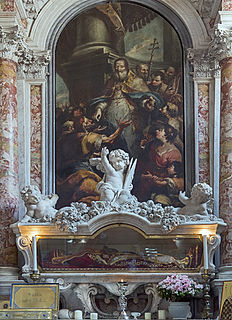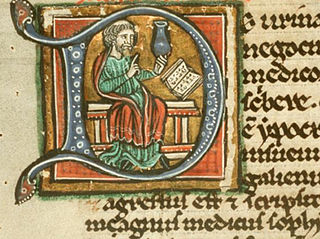 W
WPaolo Lucio Anafesto was, according to tradition, the first Doge of Venice, serving from 697 to 717.
 W
WAnastasius Sinaïta, also called Anastasios of Sinai, was a seventh-century Greek ecclesiastical writer, priest, monk, and abbot of Saint Catherine's Monastery at Mount Sinai.
 W
WAndreas of Caesarea was a Greek theological writer and bishop of Caesarea in Cappadocia. Karl Krumbacher assigned him to the first half of the sixth century. He is variously placed by other scholars, from the fifth to the ninth century. However, today it is unquestionable that his life spanned the late sixth/early seventh centuries.
 W
WAndrew of Crete, also known as Andrew of Jerusalem, was an 8th-century bishop, theologian, homilist, and hymnographer. He is venerated as a saint by Eastern Orthodox and Roman Catholic Christians.
 W
WConstantina was the Empress consort of Maurice of the Byzantine Empire. She was a daughter of Tiberius II Constantine and Ino Anastasia. Her parentage was recorded in the chronicles of Theophylact Simocatta, Paul the Deacon and John of Biclaro.
 W
WPope Damian of Alexandria, 35th Pope of Alexandria & Patriarch of the See of St. Mark.
 W
WEleazar ben Kalir, also known as Eleazar HaKalir, Eleazar ben Killir or Eleazar Kalir was a Byzantine Jew and a Hebrew poet whose classical liturgical verses, known as piyut, have continued to be sung through the centuries during significant religious services, including those on Tisha B'Av and on the sabbath after a wedding. He was one of Judaism's earliest and most prolific of the paytanim. He wrote piyutim for all the main Jewish festivals, for special Sabbaths, for weekdays of festive character, and for the fasts. Many of his hymns have found their way into festive prayers of the Ashkenazi Jews' synagogal rite.
 W
WSaint Eumenes was a bishop of Gortyna in Crete during the 7th century. His feast day occurs on September 18. He gave up his wealth as a young man and was chosen as bishop of Gortyna. Many miracles are attributed to him: he killed a venomous snake, drove out demons, and healed the sick. He performed miracles at Gortyna, Rome, and in the Thebaid. He died in exile in the Thebaid.
 W
WGermanus I was the Patriarch of Constantinople from 715 to 730. He is regarded as a saint, by both the Orthodox and Roman Catholic Churches, with a feast day of 12 May. He had been ecumenically preceded by Patriarch John VI of Constantinople, and was succeeded in Orthodox rite by patriarch Constantine II of Constantinople.
 W
WPope Gregory I, commonly known as Saint Gregory the Great, was the bishop of Rome from 3 September 590 to his death. He is known for instigating the first recorded large-scale mission from Rome, the Gregorian Mission, to convert the then-pagan Anglo-Saxons in England to Christianity. Gregory is also well known for his writings, which were more prolific than those of any of his predecessors as pope. The epithet Saint Gregory the Dialogist has been attached to him in Eastern Christianity because of his Dialogues. English translations of Eastern texts sometimes list him as Gregory "Dialogos", or the Anglo-Latinate equivalent "Dialogus".
 W
WHeraclius the Elder was a Byzantine general and the father of Byzantine emperor Heraclius. Of possible Armenian origin, Heraclius the Elder distinguished himself in the war against the Sassanid Persians in the 580s. As a subordinate general, Heraclius served under the command of Philippicus during the Battle of Solachon and possibly served under Comentiolus during the Battle of Sisarbanon. In circa 595, Heraclius the Elder is mentioned as a magister militum per Armeniam sent by Emperor Maurice to quell an Armenian rebellion led by Samuel Vahewuni and Atat Khorkhoruni. In circa 600, he was appointed as the Exarch of Africa and in 608, Heraclius the Elder rebelled with his son against the usurper Phocas. Using North Africa as a base, the younger Heraclius managed to overthrow Phocas, beginning the Heraclian dynasty, which would rule Byzantium for a century. Heraclius the Elder died soon after receiving news of his son's accession to the Byzantine throne.
 W
WCyrrhus is a city in ancient Syria founded by Seleucus Nicator, one of Alexander the Great's generals. Other names for the city include Hagioupolis, Nebi Huri, Khoros. A false etymology of the sixth century connects it to Cyrus, king of Persia due to the resemblance of the names. The former Roman/Byzantine (arch)bishopric is now a double Catholic titular see.
 W
WJohn the Merciful, also known as St John the Almsgiver, John the Almoner, John V of Alexandria, John Eleymon, and Johannes Eleemon, was the Chalcedonian Patriarch of Alexandria in the early 7th century and a Christian saint. He is the patron saint of Casarano, Italy and of Limassol, Cyprus.
 W
WMaximus the Confessor, also known as Maximus the Theologian and Maximus of Constantinople, was a Christian monk, theologian, and scholar.
 W
WMizizios was an Armenian noble who served as a general of Byzantium, later usurping the Byzantine throne in Sicily from 668 to 669.
 W
WPaul of Aegina or Paulus Aegineta was a 7th-century Byzantine Greek physician best known for writing the medical encyclopedia Medical Compendium in Seven Books. "He is the father of early medical books". For many years in the Byzantine Empire, this work contained the sum of all Western medical knowledge and was unrivaled in its accuracy and completeness.
 W
WTheophilus Protospatharius was the author of several extant Greek medical works of uncertain status, either from Philaretus or Philotheus. Nothing is known of his life or the time when he lived. He is generally called "Protospatharius", which seems to have been originally a military title given to the colonel of the bodyguards of the emperor of Constantinople (Spatharioi); but which afterwards became also a high court title, or was associated with the government of provinces and the functions of a judge.
 W
WAelia Sophia was the Empress consort of Justin II of the Byzantine Empire, and regent during the incapacity of her spouse from 573 until 578. She was specifically interested in economic matters and was involved in financial matters during Justin's reign.
 W
WSophronius, called Sophronius the Sophist, was the Patriarch of Jerusalem from 634 until his death. He is venerated as a saint in the Eastern Orthodox and Catholic Churches. Before rising to the primacy of the see of Jerusalem, he was a monk and theologian who was the chief protagonist for orthodox teaching in the doctrinal controversy on the essential nature of Jesus and his volitional acts.
 W
WSaint Theodore of Sykeon was a revered Byzantine ascetic, who lived between the first half of the 6th century and the thirteenth year of the Emperor Heraclius' rule in the early 7th century. His hagiography, written after 641, is a key primary source for the reign of Emperor Heraclius. His feast day is April 22.
 W
WTheodore of Tarsus was Archbishop of Canterbury from 668 to 690. Theodore grew up in Tarsus, but fled to Constantinople after the Persian Empire conquered Tarsus and other cities. After studying there, he relocated to Rome and was later installed as the Archbishop of Canterbury. Accounts of his life appear in two 8th-century texts. Theodore is best known for his reform of the English Church and establishment of a school in Canterbury.
 W
WTimothy of Constantinople was a Chalcedonian Christian heresiologist and presbyter of the church of Hagia Sophia in Constantinople. He wrote a treatise in Greek on Christian heresies from a Chalcedonian perspective, On Those Who Enter the Church, or On the Reception of Heretics. This pastoral work is best described as "a handbook on the procedure for admitting heretics to the church".